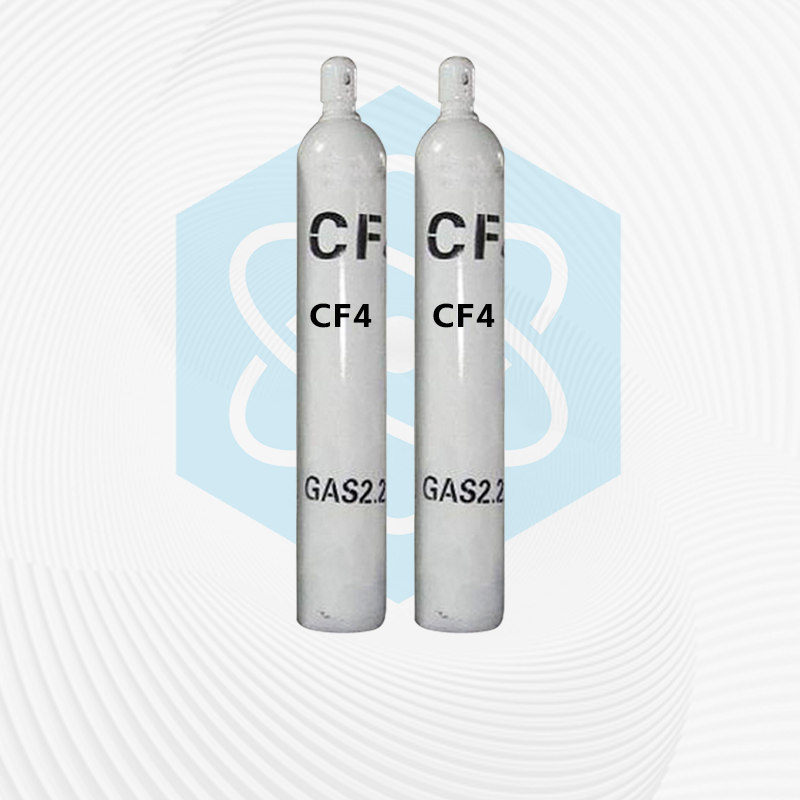คำอธิบายของก๊าซ
เตตระฟลูออโรคาร์บอน หรือเรียกอีกอย่างว่าเตตระฟลูออโรมีเทน ก๊าซไม่มีสี ไม่มีกลิ่น และไม่มีกลิ่น ไม่ละลายน้ำ 0.0015 ที่อุณหภูมิ 25 ℃ ภายใต้ความดันปกติ ละลายได้ในคลอโรฟอร์มและเบนซิน ผลิตภัณฑ์นี้ไม่เป็นพิษและไม่ติดไฟ เมื่อใช้ในความเข้มข้นสูง จะมีฤทธิ์ระงับความรู้สึก ก๊าซที่มีความบริสุทธิ์สูงและส่วนผสมกับออกซิเจนที่มีความบริสุทธิ์สูงเป็นก๊าซกัดกร่อนพลาสมาที่ใช้กันอย่างแพร่หลายที่สุดในอุตสาหกรรมไมโครอิเล็กทรอนิกส์ในปัจจุบัน Chemicalbook ยังสามารถใช้เป็นสารทำความเย็นอุณหภูมิต่ำและตัวกลางฉนวนได้อีกด้วย มีเสถียรภาพทางเคมีและความร้อนที่ดี เฉื่อยต่อรีเอเจนต์หลายชนิด ไม่ไฮโดรไลซ์ที่อุณหภูมิ 1,000 ℃ ไม่ทำปฏิกิริยากับทองแดง นิกเกิล และทังสเตนที่อุณหภูมิห้อง เนื่องจากความเสถียรทางเคมีที่แข็งแกร่งของพันธะ CF จึงถือได้ว่าเพอร์ฟลูออโรคาร์บอนที่แสดงโดย CF4 นั้นไม่มีพิษโดยพื้นฐาน
การใช้งานหลัก
ปัจจุบันคาร์บอนเตตระฟลูออไรด์เป็นก๊าซกัดกร่อนพลาสม่าที่ใช้กันอย่างแพร่หลายที่สุดในอุตสาหกรรมไมโครอิเล็กทรอนิกส์ โดยนิยมใช้กัดกร่อนวัสดุฟิล์มบาง เช่น ซิลิกอน ซิลิกอนไดออกไซด์ ซิลิกอนไนไตรด์ แก้วฟอสโฟโรซิลิเกต และทังสเตน นอกจากนี้ยังนิยมใช้ทำความสะอาดพื้นผิวของอุปกรณ์อิเล็กทรอนิกส์ การผลิตเซลล์แสงอาทิตย์ เทคโนโลยีเลเซอร์ ระบบทำความเย็นอุณหภูมิต่ำ ฉนวนป้องกันก๊าซ สารตรวจจับการรั่วไหล การควบคุมทิศทางของจรวดอวกาศ สารทำความสะอาด สารหล่อลื่น และน้ำมันเบรกในการผลิตวงจรพิมพ์ เนื่องจากมีความเสถียรทางเคมีสูง CF4 จึงสามารถใช้ในอุตสาหกรรมต่างๆ เช่น การถลุงโลหะและพลาสติกได้
การจัดเก็บและข้อควรระวัง
จัดเก็บในคลังสินค้าที่เย็นและมีการระบายอากาศสำหรับก๊าซที่ไม่ติดไฟโดยเฉพาะ หลีกเลี่ยงประกายไฟและแหล่งความร้อน อุณหภูมิในการจัดเก็บไม่ควรเกิน 30 ℃ ควรจัดเก็บแยกจากวัสดุที่ติดไฟได้และสารออกซิไดเซอร์ และควรหลีกเลี่ยงการจัดเก็บแบบผสม ควรติดตั้งอุปกรณ์ตอบสนองฉุกเฉินสำหรับการรั่วไหลในพื้นที่จัดเก็บ




